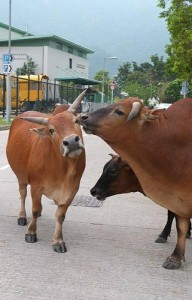Although Hong Kong is a highly industrialized and modern city, agriculture was vibrant several decades ago in rural areas, and back then yellow cattle were the local farmers’ best companions and helpers. Nowadays there is little agricultural activity left and the cattle are retired, with only very few of them still living in rural areas.
In Mui Wo, a rural town on the eastern coast of Lantau Island, there are still 14 yellow cattle living within the community. They were let free by local farmers who gave up cultivation 20 to 30 years ago. However, in a meeting in June 2012, the Mui Wo district rural committee pressured the Agriculture, Fisheries and Conservation Department to implement a “zero cattle” policy with the pretext that the cattle are distributing the traffic. Eventually a compromise was met within the meeting that only six of the cattle can remain.
Since the meeting was close door without public participation, animal rights activists and local residents, especially those who move in from urban areas oppose to the agreement and insist that all the 14 cattle should be continue to live in the community.
According to the report [zh] from inmediahk.net, the pressure to relocate the yellow cattle started six years ago because of a development plan:
遷移黃牛的問題已不止是發生於今日,至少六年前也發生同樣的事。規劃處計劃將梅窩打造成新的旅遊景點,於是牛群便變成阻街,阻礙發展。這種發展的壓力,在香港樓價地價持續上升的環境下,在六年後的今日只會更大。
As many local residents and animal rights activists protested again the plan, the rural committee claimed that the eight yellow cattle to be moved will be relocated to the Hong Kong Wetland Park. However, different from water buffalos, yellow cattle have to live in a dry environment and the proposed new home would expose them to skin diseases, explains animal activist Ho Loy.
She has also criticized [zh] the decision making process and the government's animal policy:
香港政府對鄉郊的地方管治落伍,現在的管理方式只是透過民政事務專員與各鄉村代表,如鄉事委員會或村長等會面決定。會面內容不但不是正式官方會談,而且是不公開,甚至沒有一個詳細的會面紀錄。不論是原居民代表或居民代表,均以家族式管治,只可以是同族村民擔任,而由村外搬入的居民難以進入村代表的架構內。村代表又欠缺問責意識,幾乎是一人說了算。
香港的政策向來就只有兩種動物,一是流浪動物,而另一種則是寵物。對於流浪動物,政府過往的做法就只有捕捉及人道毀滅。「他們只會保留動物四天,看是否有人會前來領回,如果沒有就人道毀滅。」然而,對於流浪牛來說,相比普通的貓狗,牛隻因體形大而更難捕捉。因此,對於流浪牛隻的做法更不人道。
A Facebook event page was set up around end of July 2012 to save the yellow cattle in Mui Wo. The activists urged concerned citizens to send an open letter to the government:
據了解,現時梅窩的黃牛,眾居當地多時,屬同一牛家群,自我管理整齊,每天都是一隻跟一隻的走過田野,牛牛和大佛已是大嶼山的代表, 大嶼山的巴士和旅遊宣傳亦有牛的形象; 這些牛的存在,構成了梅窩的獨特鄉土文化。
若人為的將14黃牛家群分開,對牛牛和社區都有很大影響,包括小的牛沒有母親,大的牛沒有牛首,空降別處亦會造成牛首相爭,流離浪盪。 人人皆知這14黃牛的公牛已全部節育,很多居民包括大人小孩, 都知道牠們是梅窩最後一群黃牛,再沒下一代, 對這群黃牛載滿感情,其情殷殷可鍳。
So far, more than 4,000 people have shown their support on Facebook and the government has agreed to arrange a meeting between the rural committee and animal rights activists later this week on August 25, 2012.








